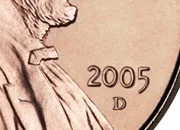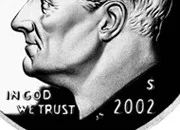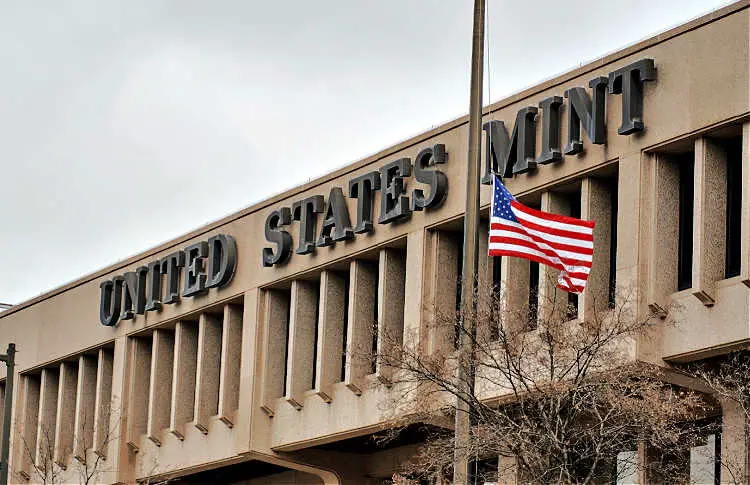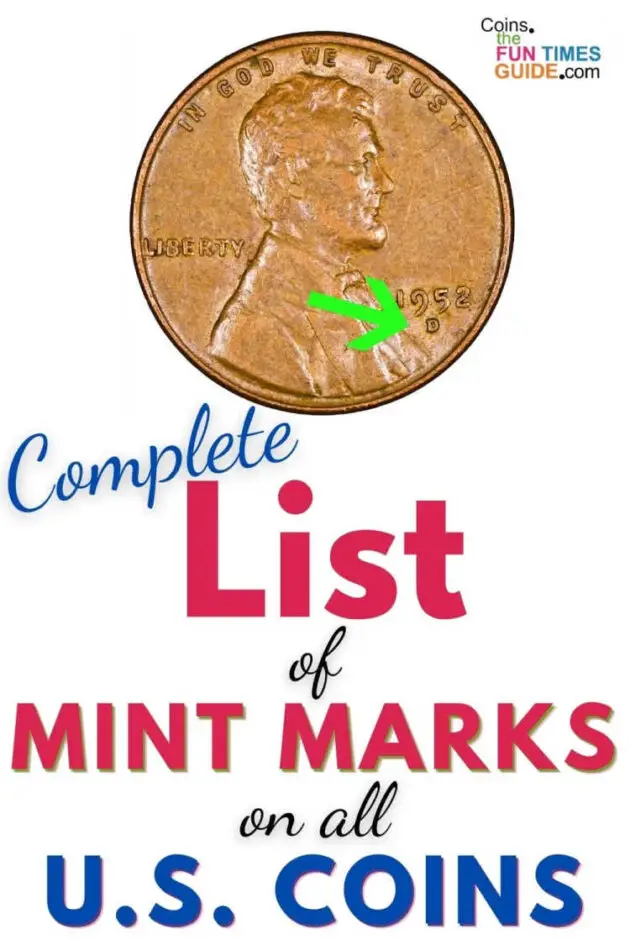There’s a lot of talk about “mint” whenever you’re discussing coins and coin collections!
Some examples:
- First, there’s the U.S. Mint — which is the federal agency responsible for the production and distribution of our nation’s coinage.
- Then, there are mint coins (or mint condition coins) — which refers to a coin that is in practically the same condition as when it left the U.S. Mint facility.
- And then you have mint sets — which are collections of uncirculated coins for a particular year. (A mint set includes one uncirculated coin of each denomination from each U.S. Mint facility that produced the denomination during that year.)
- And finally, you have mint marks — which we are focusing on in this article.


What Is A Mint Mark?
Mintmarks are small letters stamped on U.S. coins to designate where the coin was made.
The mint mark can affect a coin’s value!
In a lot of cases, where the coin was minted makes the difference between a coin being worth a few dollars and being worth a few hundred dollars!
Almost all U.S. coins have mintmarks — with the exception of some coins struck at the Philadelphia Mint and some error coins (listed at the very bottom of this article).
A List Of All U.S. Mint Marks

C – Charlotte Mint – North Carolina (gold coins only from 1838-1861)
CC – Carson City Mint – Nevada (gold and silver coins only from 1870-1893)
D – Dahlonega Mint – Georgia (gold coins only from 1838-1861)
D – Denver Mint – Colorado (from 1906-present)
O – New Orleans Mint – Louisiana (gold and silver coins only from 1838-1861 and from 1879-1909)
P – Philadelphia Mint – Pennsylvania (from 1793-present)
S – San Francisco Mint – California (from 1854-present, but from 1968 on it has primarily struck only proof coins and other special-issue coinage)
W – West Point Mint – New York (from 1984-present)
You can distinguish Dahlonega “D” coins from Denver “D” coins merely by looking at the date on the coin. Any “D” mintmark coins dated before 1906 are from the Dahlonega Mint. Those after 1906 were made at the Denver Mint.
The only mintmarks you’re going to find on circulating coins today are P (Philadelphia), D (Denver), and S (San Francisco).
All of the other U.S. Mint facilities either closed down a long time ago — or they only make gold coins and specialty coins today.
Here’s more info about current and former United States Mint facilities.
Where To Find Mint Marks On U.S. Coins
Over the years, mintmarks have been placed in all sorts of locations on coins.
Generally speaking, mint marks were placed on the reverse of coins until 1968 — the year that mintmarks moved to the obverse.
To break it all down for you, I’m going to cover the most common coins that were ever in circulation.
I will start with the silver dollar and work back to the half cent — so you will know exactly where the mintmark should appear on each particular coin.
Silver Trade Dollars – On the reverse, underneath the eagle
Silver Peace Dollars – On the reverse, bottom left next to the tip of the eagle’s wing
Silver Morgan Dollars – On the reverse, underneath the eagle
Silver Bust Dollars – On the reverse, underneath the eagle
Kennedy Half Dollars:
- Pre-1965 – On the reverse, to the left of the olive branch near the eagle’s claw
- 1968-present – On the obverse, centered above the date
Franklin Half Dollars – On the reverse, centered above the beam of the Liberty bell
Walking Liberty Half Dollars:
- 1917-1947 – On the reverse, bottom left below the branch
- 1916 & 1917 – On the obverse, below the motto
Barber Half Dollars – On the reverse, just below the eagles tail feathers
Seated Liberty Half Dollars – On the reverse, below the eagle
Bust Half Dollars:
- 1838-1839 – On the obverse, above the date
- before 1838 – All bust half dollars before 1938 have no mintmark
Washington Quarters:
- 1968-present – On the obverse, bottom right next to the hair ribbon
- 1946-1964 – On the reverse, below the eagle
Standing Liberty Quarters – Small mintmark on the obverse, just above the date and a hair to the left
Barber Quarters – On the reverse, beneath the eagle’s tail feathers
Seated Liberty Quarters – On the reverse, beneath the eagle
Bust Quarters – All bust quarters have no mintmark (Philadelphia Mint)
Seated Liberty 20-Cent Pieces – On the reverse beneath the eagle
Roosevelt Dimes:
- 1968-present – On the front above the date
- 1946-1964 – On the reverse, bottom left of the torch
Mercury Dimes – On the reverse, bottom left of the fasces (column or pole looking thing)
Barber Dimes – On the reverse centered below the wreath
Seated Liberty Dimes – Some are located within the wreath; others are located just beneath the wreath
Bust Dimes – All bust dimes have no mintmark (Philadelphia)
Seated Liberty Half Dimes – Some have mintmarks within the wreath, and some have mint marks beneath the wreath
Bust Half Dimes – All bust half dimes have no mintmark (Philadelphia)
Jefferson Nickels:
- 1968-present – On the obverse, near the date
- 1938-1964 – On the reverse, to the right of the Monticello building
- 1942-1945 (war nickels) – On the reverse, above the dome of Monticello
Buffalo Nickels – On the reverse, below the words FIVE CENTS
Liberty Head Nickels (“V Nickels”) – All V nickels have no mark (Philadelphia Mint) — with the exception of the year 1912, in which case the mintmark is on the reverse to the left of the word CENTS
Shield Nickels – All shield nickels have no mint mark (Philadelphia Mint)
3-Cent Pieces – All 3-cent pieces have no mintmark (Philadelphia Mint) — with the exception of the year 1851, in which case the mark is on the reverse to the right of the Roman numeral III
2-Cent Pieces – All 2-cent pieces have no mint mark (Philadelphia Mint)
Lincoln Cents – On the obverse, beneath the date
Indian Head Cents – All Indian head cents have no mintmark — with the exception of 1908 and 1909, in which case the mark is on the reverse beneath the wreath
Flying Eagle Cents – All flying eagle cents have no mint mark (Philadelphia Mint)
Large Cents – All large cents have no mint mark (Philadelphia Mint)
Half Cents – All half cents have no mintmark (Philadelphia Mint)
And there you have it… now you know where to find the mint marks on all of your U.S. coins!
U.S. Coins Without Mintmarks

Have a coin without a mintmark?
Unfortunately, mint marks have not been used consistently by the U.S. Mint.
For example, the Philadelphia Mint didn’t use the “P” mintmark for the first time until 1942 and wouldn’t use it regularly until after 1978. The only coins minted before 1979 that have a mintmark from the Philadelphia Mint are Jefferson nickels struck between 1942 and 1945 (a.k.a. war nickels).
See why a specific coin does not have a mint mark… and how to tell which U.S. Mint facility that coin was made in:
- There are no mint marks on U.S. coins dated 1965, 1966, and 1967.
- Rare coins that are missing mintmarks + U.S. coins that are not supposed to have mintmarks.
- Historically, coins made at the Philadelphia Mint have not had mint marks.
Like this post? Save it to read again later… or share with others on Pinterest!

I’m the Coin Editor here at TheFunTimesGuide. My love for coins began when I was 11 years old. I primarily collect and study U.S. coins produced during the 20th century. I’m a member of the American Numismatic Association (ANA) and the Numismatic Literary Guild (NLG) and have won multiple awards from the NLG for my work as a coin journalist. I’m also the editor at the Florida United Numismatists Club (FUN Topics magazine), and author of Images of America: The United States Mint in Philadelphia (a book that explores the colorful history of the Philadelphia Mint). I’ve contributed hundreds of articles for various coin publications including COINage, The Numismatist, Numismatic News, Coin Dealer Newsletter, Coin Values, and CoinWeek. I’ve authored nearly 1,000 articles here at The Fun Times Guide to Coins (many of them with over 50K shares), and I welcome your coin questions in the comments below!

